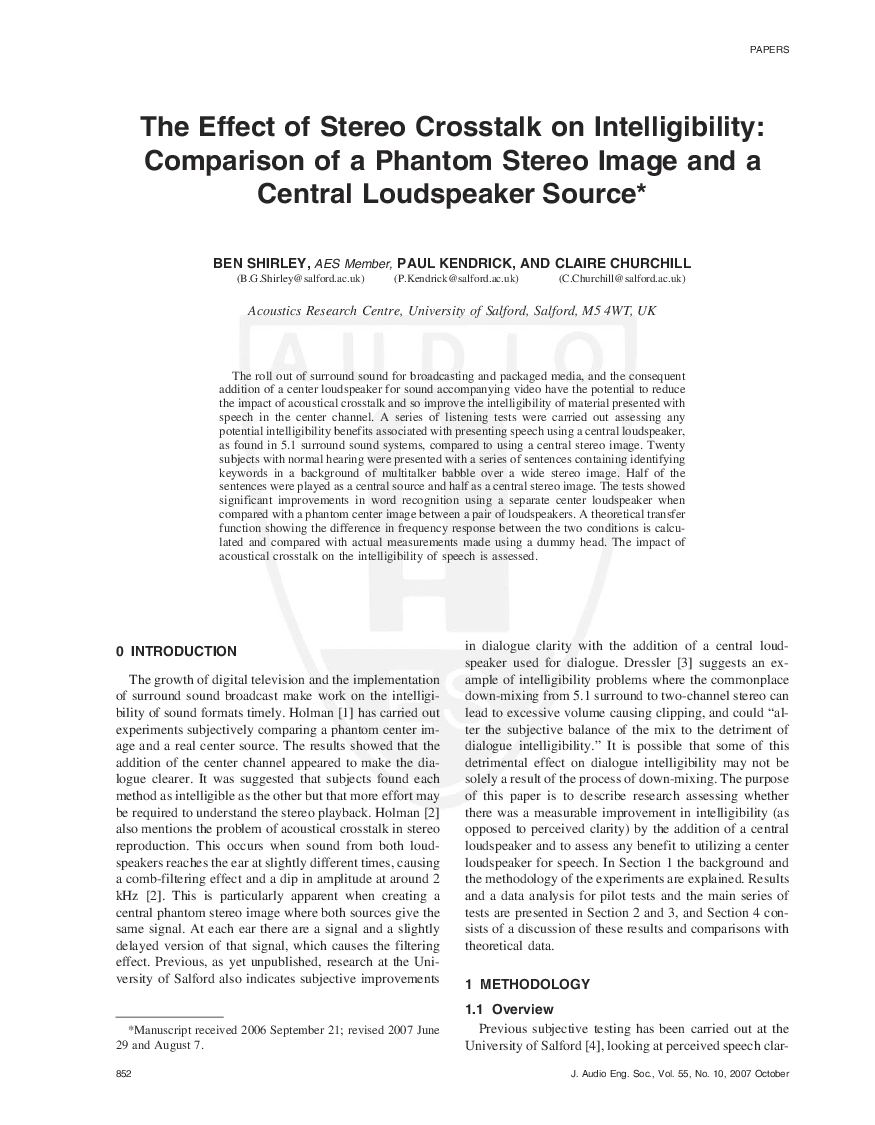Home / Publications / E-library page
You are currently logged in as an
Institutional Subscriber.
If you would like to logout,
please click on the button below.
Home / Publications / E-library page
Only AES members and Institutional Journal Subscribers can download
The roll out of surround sound for broadcasting and packaged media, and the consequent addition of a center loudspeaker for sound accompanying video have the potential to reduce the impact of acoustical crosstalk and so improve the intelligibility of material presented with speech in the center channel. A series of listening tests were carried out assessing any potential intelligibility benefits associated with presenting speech using a central loudspeaker, as found in 5.1 surround sound systems, compared to using a central stereo image. Twenty subjects with normal hearing were presented with a series of sentences containing identifying keywords in a background of multitalker babble over a wide stereo image. Half of the sentences were played as a central source and half as a central stereo image. The tests showed significant improvements in word recognition using a separate center loudspeaker when compared with a phantom center image between a pair of loudspeakers. A theoretical transfer function showing the difference in frequency response between the two conditions is calculated and compared with actual measurements made using a dummy head. The impact of acoustical crosstalk on the intelligibility of speech is assessed.
Author (s): Shirley, Ben; Kendrick, Paul; Churchill, Claire
Affiliation:
Acoustics Research Centre, University of Salford, Salford, UK
(See document for exact affiliation information.)
Publication Date:
2007-10-06
Import into BibTeX
Permalink: https://aes2.org/publications/elibrary-page/?id=14174
(950KB)
Click to purchase paper as a non-member or login as an AES member. If your company or school subscribes to the E-Library then switch to the institutional version. If you are not an AES member Join the AES. If you need to check your member status, login to the Member Portal.

Shirley, Ben; Kendrick, Paul; Churchill, Claire; 2007; The Effect of Stereo Crosstalk on Intelligibility: Comparison of a Phantom Stereo Image and a Central Loudspeaker Source [PDF]; Acoustics Research Centre, University of Salford, Salford, UK; Paper ; Available from: https://aes2.org/publications/elibrary-page/?id=14174
Shirley, Ben; Kendrick, Paul; Churchill, Claire; The Effect of Stereo Crosstalk on Intelligibility: Comparison of a Phantom Stereo Image and a Central Loudspeaker Source [PDF]; Acoustics Research Centre, University of Salford, Salford, UK; Paper ; 2007 Available: https://aes2.org/publications/elibrary-page/?id=14174
@article{shirley2007the,
author={shirley ben and kendrick paul and churchill claire},
journal={journal of the audio engineering society},
title={the effect of stereo crosstalk on intelligibility: comparison of a phantom stereo image and a central loudspeaker source},
year={2007},
volume={55},
issue={10},
pages={852-863},
month={october},}
TY – paper
TI – The Effect of Stereo Crosstalk on Intelligibility: Comparison of a Phantom Stereo Image and a Central Loudspeaker Source
SP – 852 EP – 863
AU – Shirley, Ben
AU – Kendrick, Paul
AU – Churchill, Claire
PY – 2007
JO – Journal of the Audio Engineering Society
VO – 55
IS – 10
Y1 – October 2007